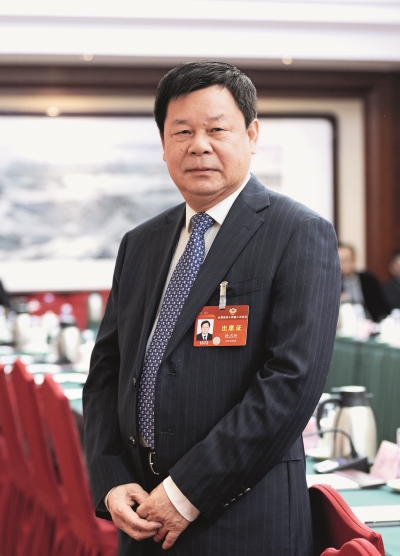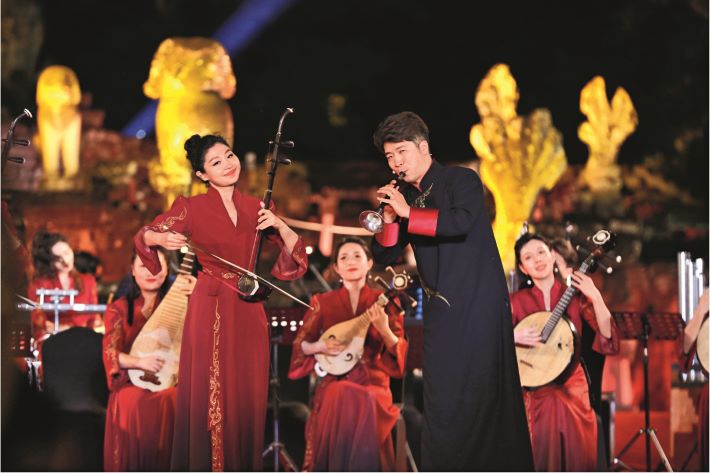|
||||||||||
| Home Nation World Business Opinion Lifestyle ChinAfrica Multimedia Columnists Documents Special Reports |
|
||||||||||
| Home Nation World Business Opinion Lifestyle ChinAfrica Multimedia Columnists Documents Special Reports |
| ChinAfrica |
| Putting People Above All |
| Telling good stories about China’s modernisation key to promoting a better understanding |
| By Du Zhanyuan | VOL. 16 April 2024 ·2024-04-03 |

Du Zhanyuan, a member of the Standing Committee of the 14th CPPCC National Committee and president of the CICG (DUAN WEI)
With over 200 countries and regions, more than 2,500 ethnic groups, and various religions in existence today, different civilisations have evolved, based on diverse histories, national conditions and customs. People-to-people exchanges and interactions play a crucial role in promoting people-to-people ties and enhancing exchanges and mutual learning. In today’s world, as changes unseen in a century accelerate, exchanges and mutual learning between diverse cultures are more necessary and important than ever.
A bridge of friendly exchange and integration should be built based on the coexistence of civilisations. The exchanges and mutual learning between civilisations should not be based on the monopoly of one civilisation or denigration of another. Only by respecting the diversity of civilisations and promoting dialogue, peaceful coexistence and harmony among civilisations can the richness of human civilisation be enhanced, and the prospects for human development become brighter.
We should implement the Global Development Initiative and the Global Security Initiative and follow the prevailing trend of our times - peace and development. We should draw on the best of all civilisations to adopt a people-first development philosophy, a development vision of mutual benefit, a development approach of harmonious coexistence, and measures to enhance solidarity and cooperation. We should respond to the call of people worldwide for peace and development, promote building a community with a shared future for humankind, and seek the broadest common understanding on building a beautiful world.
China’s modernisation drive
Chinese modernisation has broken away from the patterns of Western-style modernisation. It has proven its feasibility and effectiveness, representing a significant innovation of the global modernisation theory and practice. For many developing countries, it offers an alternative to independent modernisation paths.
Telling good stories of Chinese modernisation is key to overcoming international prejudices against China and helping the world to understand the Communist Party of China (CPC), China, and the Chinese nation. To achieve mutual understanding between China and the rest of the world and tell absorbing stories of Chinese modernisation to international audiences, we must first accurately grasp the essence and characteristics of Chinese modernisation. Chinese modernisation shares common features with the modernisation of other countries but at the same time also possesses distinct characteristics based on its own national conditions.
Second, it’s essential to present the successful practices of Chinese modernisation in all aspects through vivid examples via diverse communication channels and multimedia formats to audiences from different cultures and backgrounds. Chinese modernisation represents the creative transformation and innovative development of Chinese civilisation. Communication about it requires an open, inclusive attitude and open and transparent dialogue platforms. Through international conferences, academic seminars, cultural exchange activities and other channels, we should encourage all parties to share their understanding and opinions on Chinese modernisation, break down cultural barriers, and enable the international community to gain a deeper understanding of China’s cultural heritage and path to modernisation.
AI and international communication
Currently, a new round of technological revolution and industrial change led by artificial intelligence (AI) is accelerating, profoundly changing public opinion, the media landscape and communication methods in international communication. But technology is a double-edged sword. While new technologies such as AI should be highly valued and explored to promote innovation in international communication, measures must also be taken to prevent the phenomenon of “bad money driving out the good” in the international public opinion arena due to technological competition.
As an international communication organisation, China International Communications Group (CICG) is exploring the application of new technologies such as AI, big data, the Internet of Things, 5G, smart robots and computer vision in international communication, contributing to the upgrading of China’s international image in the new era. Empowering the national translation capacity through new technologies has facilitated the rapid development of new translation formats such as remote translation and online simultaneous interpretation, enabling massive translation outputs in multiple languages.
CICG has adopted an integrated development vision, keeps exploring new paths for the application of AI in mass communication, and cultural and people-to-people exchange, and utilises new technologies for process optimisation, platform reconstruction, and management restructuring to improve the effectiveness of China’s international communication.

Chinese artists perform during the launch ceremony of the 2024 Cambodia-China People-to-People Exchange Year in Siem Reap Province, Cambodia, on 13 January (XINHUA)
Information gap
China-related global opinion polls with significant international influence are still dominated by Western polling companies, research institutions, media organisations and industry groups. With English-language information accounting for more than 70 percent of online contents, most international audiences learn about China through Western media. However, the international community generally expects China to play a greater role in the international order and global governance, and to hear China’s voice more on major issues.
International communication should be carried out in multiple forms and on varied platforms to meet the international audiences’ need for information about China in various aspects.
First, it is necessary to innovate the content of international communication, covering not only the Chinese path to modernisation, but also a community with a shared future for humankind. We need to focus on global governance, economic recovery, climate change, environmental protection, technological advances, AI, humanitarianism and other areas of wide concern to the international community, and carry out targeted communication for different audiences.
Second, we should innovate the way of discourse when communicating with foreign audiences, and follow the principle of precise and targeted communication. Based on the different habits and characteristics of different foreign audiences, we need to employ widely accepted concepts and expressions to deliver China’s views and messages in response to matters of international concern. We need to present both facts and opinions, and include both the voice of Chinese people and that of personnel from other countries in our reporting. In this manner, China’s stories will be more widely recognised by the international community.
In addition, it is necessary to innovate the means and methods of international communication with mobile, visual, social communication, data and intelligent technologies. We also need to reach a broader audience and increase the Chinese communication capability, influence and credibility in talking to the international audience.
Finally, it is essential to help improve the international community’s understanding and recognition of the Chinese civilisation, the Chinese path propositions, and help the world to understand China, the Chinese people, the CPC, and the Chinese nation. We need to develop a voice in international discourse that matches China’s comprehensive national strength and international status, creating a good external environment for advancing Chinese modernisation.
The author is Member of Standing Committee of the 14th National Committee of the Chinese People’s Political Consultative Conference, and President of China International Communications Group
| About Us | Contact Us | Advertise with Us | Subscribe |
| Copyright Beijing Review All rights reserved 京ICP备08005356号-5 京公网安备110102005860号 |